
Manufacturing company Stanley Black & Decker (NYSE:SWK) reported Q4 CY2024 results topping the market’s revenue expectations, but sales were flat year on year at $3.72 billion. Its non-GAAP profit of $1.40 per share was 10.2% above analysts’ consensus estimates.
Is now the time to buy Stanley Black & Decker? Find out by accessing our full research report, it’s free.
Stanley Black & Decker (SWK) Q4 CY2024 Highlights:
- Revenue: $3.72 billion vs analyst estimates of $3.58 billion (flat year on year, 3.8% beat)
- Adjusted EPS: $1.40 vs analyst estimates of $1.27 (10.2% beat)
- Adjusted EBITDA: $378.3 million vs analyst estimates of $370.9 million (10.2% margin, 2% beat)
- Adjusted EPS guidance for the upcoming financial year 2025 is $4.05 at the midpoint, missing analyst estimates
- Operating Margin: 5.4%, down from 7.2% in the same quarter last year
- Free Cash Flow Margin: 15.2%, down from 17.3% in the same quarter last year
- Organic Revenue rose 3% year on year (-7.4% in the same quarter last year)
- Market Capitalization: $13.36 billion
Donald Allan, Jr., Stanley Black & Decker's President & CEO, commented, "Stanley Black & Decker delivered across its key focus areas in 2024 with continued gross margin expansion, strong free cash flow* generation, strengthening our balance sheet as well as making new investments aimed at driving market share growth. Against a mixed macroeconomic backdrop, we are encouraged by the growth and share gain momentum in DEWALT and within portions of engineered fastening. As we continue on this journey, we are proud to have delivered on key financial milestones, including adjusted gross margin* exceeding 31% in the fourth quarter along with strong cash generation. I want to thank our organization for their relentless focus and dedication to serving our customers and achieving these results.
Company Overview
With an iconic “STANLEY” logo which has remained virtually unchanged for over a century, Stanley Black & Decker (NYSE:SWK) is a manufacturer primarily catering to the tool and outdoor equipment industry.
Professional Tools and Equipment
Automation that increases efficiency and connected equipment that collects analyzable data have been trending, creating new demand. Some professional tools and equipment companies also provide software to accompany measurement or automated machinery, adding a stream of recurring revenues to their businesses. On the other hand, professional tools and equipment companies are at the whim of economic cycles. Consumer spending and interest rates, for example, can greatly impact the industrial production that drives demand for these companies’ offerings.
Sales Growth
A company’s long-term performance is an indicator of its overall quality. While any business can experience short-term success, top-performing ones enjoy sustained growth for years. Regrettably, Stanley Black & Decker’s sales grew at a weak 1.2% compounded annual growth rate over the last five years. This fell short of our benchmarks and is a rough starting point for our analysis.
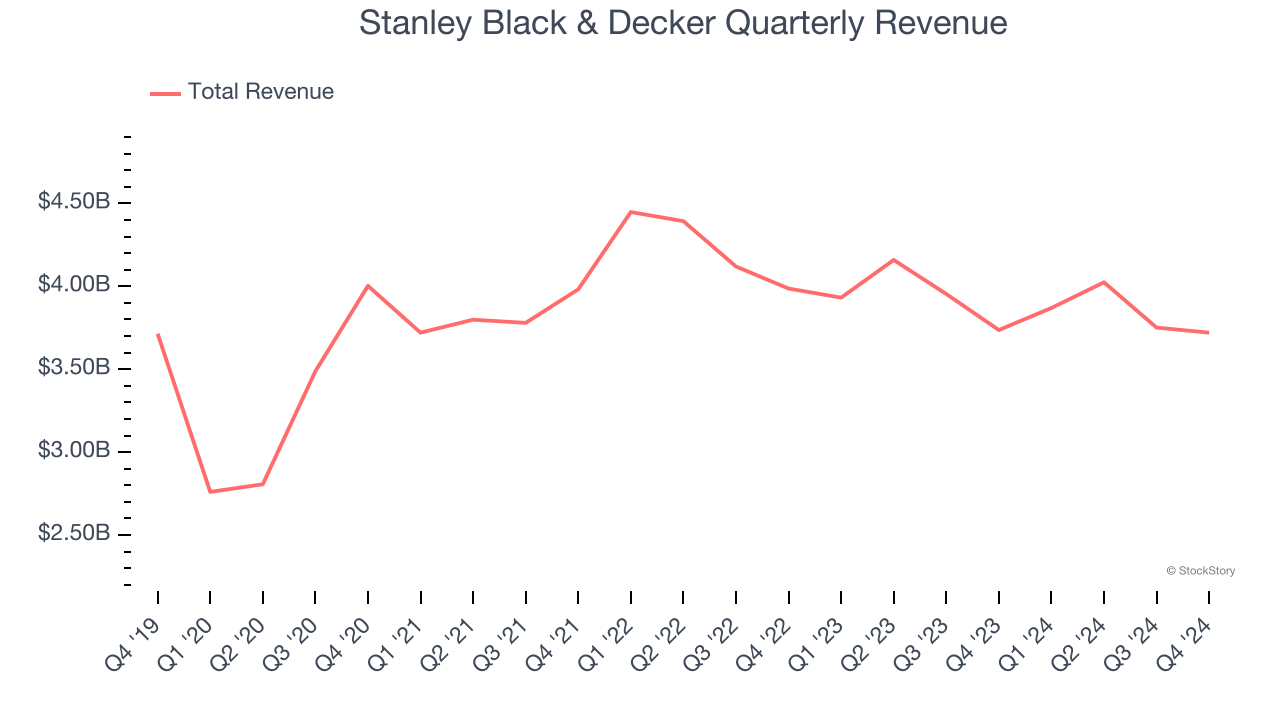
We at StockStory place the most emphasis on long-term growth, but within industrials, a half-decade historical view may miss cycles, industry trends, or a company capitalizing on catalysts such as a new contract win or a successful product line. Stanley Black & Decker’s history shows it grew in the past but relinquished its gains over the last two years, as its revenue fell by 4.8% annually. 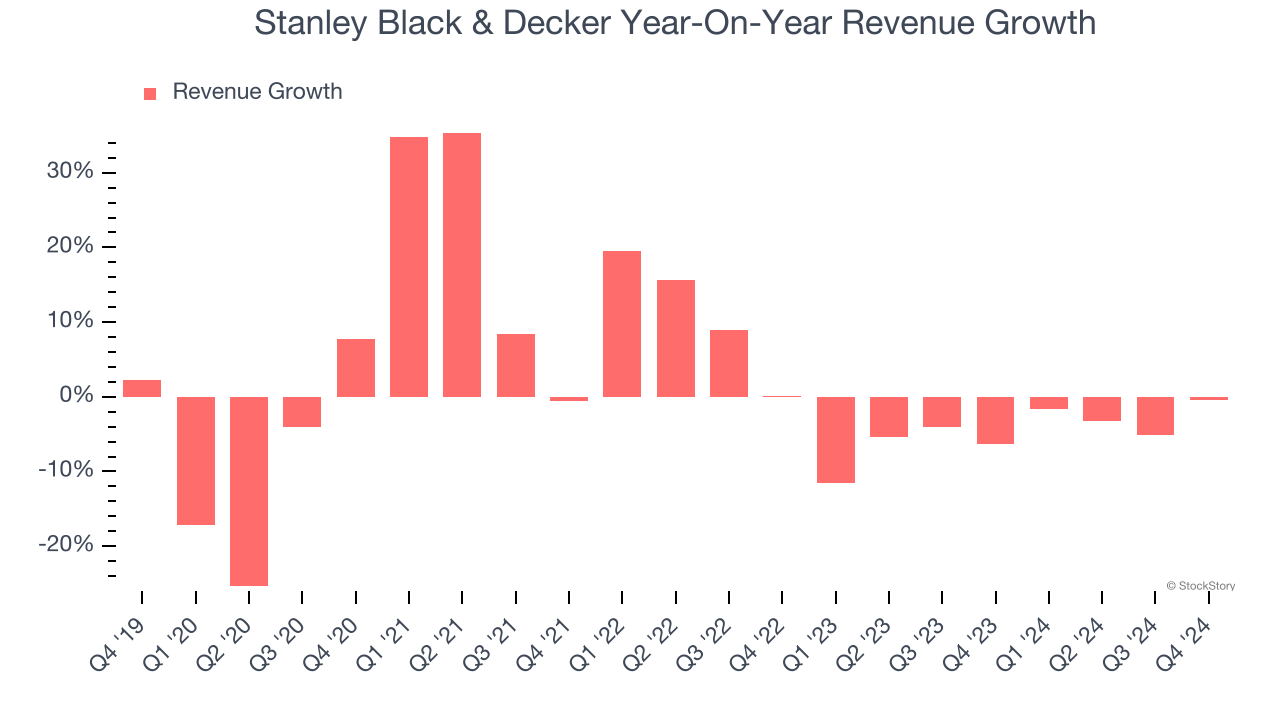
Stanley Black & Decker also reports organic revenue, which strips out one-time events like acquisitions and currency fluctuations that don’t accurately reflect its fundamentals. Over the last two years, Stanley Black & Decker’s organic revenue averaged 3% year-on-year declines. Because this number is better than its normal revenue growth, we can see that some mixture of divestitures and foreign exchange rates dampened its headline results. 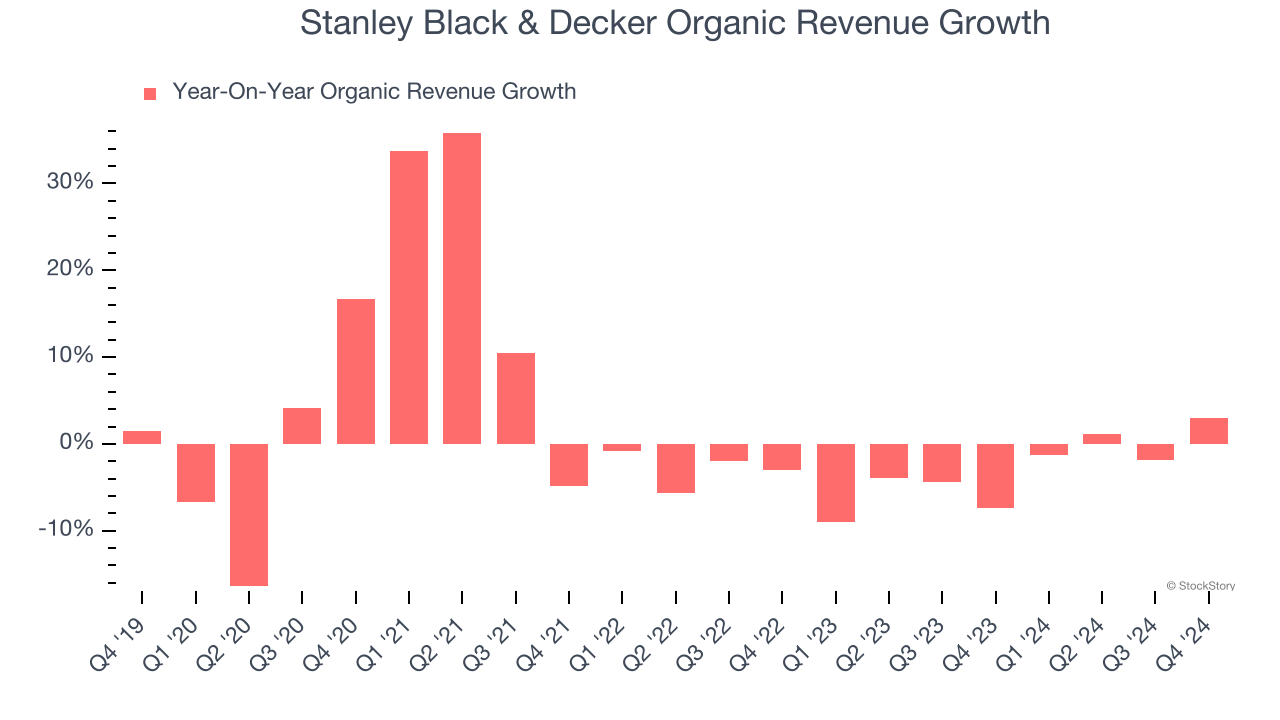
This quarter, Stanley Black & Decker’s $3.72 billion of revenue was flat year on year but beat Wall Street’s estimates by 3.8%.
Looking ahead, sell-side analysts expect revenue to remain flat over the next 12 months. While this projection suggests its newer products and services will fuel better top-line performance, it is still below the sector average.
Today’s young investors won’t have read the timeless lessons in Gorilla Game: Picking Winners In High Technology because it was written more than 20 years ago when Microsoft and Apple were first establishing their supremacy. But if we apply the same principles, then enterprise software stocks leveraging their own generative AI capabilities may well be the Gorillas of the future. So, in that spirit, we are excited to present our Special Free Report on a profitable, fast-growing enterprise software stock that is already riding the automation wave and looking to catch the generative AI next.
Operating Margin
Stanley Black & Decker has done a decent job managing its cost base over the last five years. The company has produced an average operating margin of 8.3%, higher than the broader industrials sector.
Looking at the trend in its profitability, Stanley Black & Decker’s operating margin decreased by 6.5 percentage points over the last five years. Even though its historical margin is high, shareholders will want to see Stanley Black & Decker become more profitable in the future.
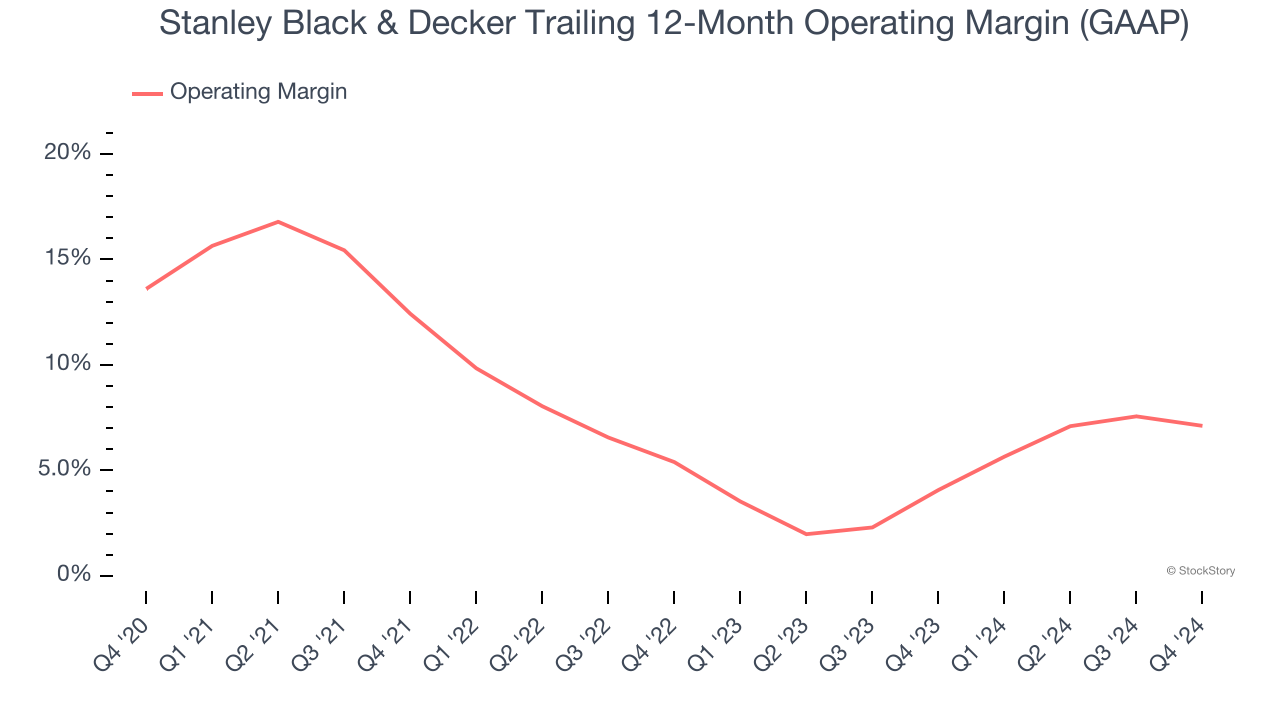
In Q4, Stanley Black & Decker generated an operating profit margin of 5.4%, down 1.9 percentage points year on year. Since Stanley Black & Decker’s operating margin decreased more than its gross margin, we can assume it was recently less efficient because expenses such as marketing, R&D, and administrative overhead increased.
Earnings Per Share
We track the long-term change in earnings per share (EPS) for the same reason as long-term revenue growth. Compared to revenue, however, EPS highlights whether a company’s growth is profitable.
Sadly for Stanley Black & Decker, its EPS declined by 12.7% annually over the last five years while its revenue grew by 1.2%. This tells us the company became less profitable on a per-share basis as it expanded.
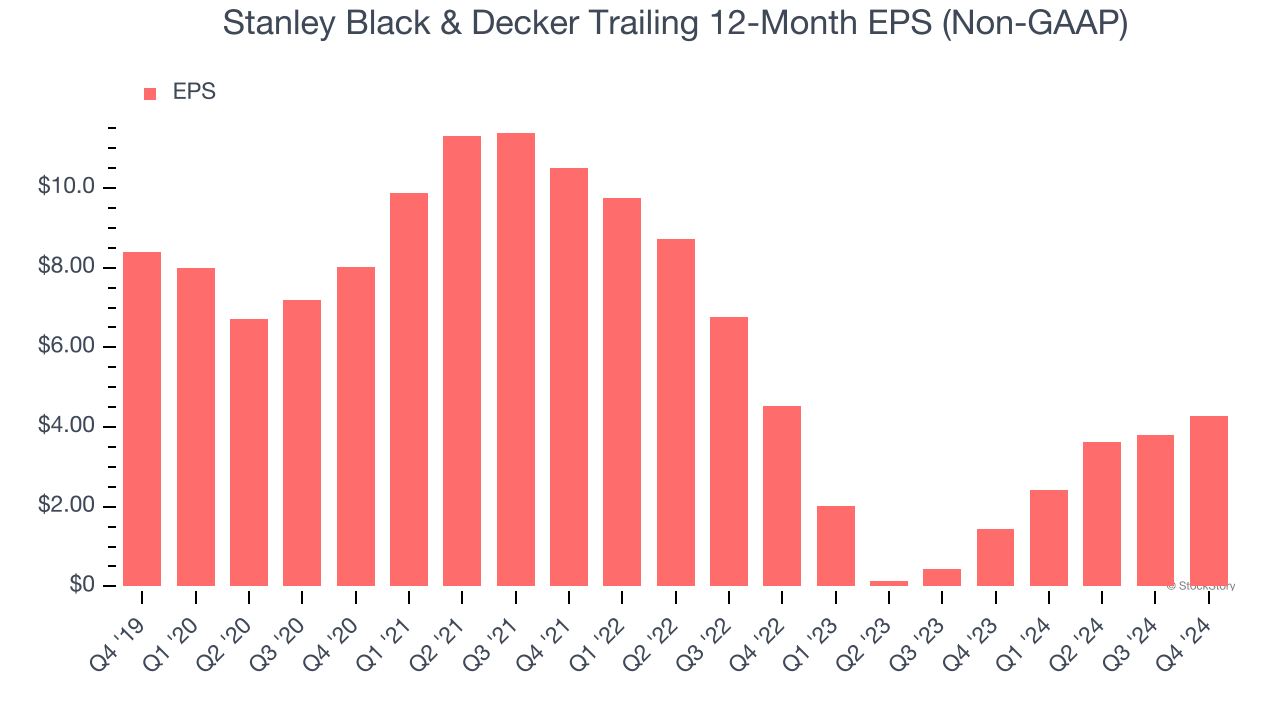
Diving into the nuances of Stanley Black & Decker’s earnings can give us a better understanding of its performance. As we mentioned earlier, Stanley Black & Decker’s operating margin declined by 6.5 percentage points over the last five years. This was the most relevant factor (aside from the revenue impact) behind its lower earnings; taxes and interest expenses can also affect EPS but don’t tell us as much about a company’s fundamentals.
Like with revenue, we analyze EPS over a shorter period to see if we are missing a change in the business.
For Stanley Black & Decker, its two-year annual EPS declines of 2.9% show it’s still underperforming. These results were bad no matter how you slice the data.
In Q4, Stanley Black & Decker reported EPS at $1.40, up from $0.92 in the same quarter last year. This print easily cleared analysts’ estimates, and shareholders should be content with the results. Over the next 12 months, Wall Street expects Stanley Black & Decker’s full-year EPS of $4.27 to grow 21%.
Key Takeaways from Stanley Black & Decker’s Q4 Results
We were impressed by how significantly Stanley Black & Decker blew past analysts’ organic revenue expectations this quarter. We were also excited its revenue outperformed Wall Street’s estimates by a wide margin. On the other hand, its full-year EPS guidance missed significantly. Overall, we think this was a mixed quarter. The stock traded down 3.7% to $83.50 immediately after reporting.
So do we think Stanley Black & Decker is an attractive buy at the current price? When making that decision, it’s important to consider its valuation, business qualities, as well as what has happened in the latest quarter. We cover that in our actionable full research report which you can read here, it’s free.
